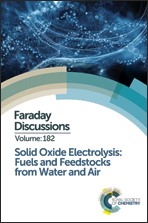Understanding the processes governing performance and durability of solid oxide electrolysis cells
Abstract
Operation of a Ni–YSZ electrode supported Solid Oxide Cell (SOC) was studied in both fuel cell mode (FC-mode) and electrolysis cell mode (EC-mode) in mixtures of H2O/H2, CO2/CO, H2O/H2O/CO2/CO at 750 °C, 800 °C and 850 °C. Although the SOCs are reversible, the polarisation characterisation shows that the kinetics for the reduction of H2O and CO2 is slower compared to oxidation of H2 and CO, and that oxidation/reduction in CO2/CO mixtures is slower than in H2O/H2 mixtures. The kinetic differences are partly related to the polarisation heating and the entropy change. Also the diffusion resistance is larger in EC-mode as compared to FC-mode and the low frequency concentration resistance (which is affected by diffusion), is asymmetric around the open circuit voltage (OCV), and is significantly higher in the EC-mode. Both the increased diffusion resistance and the asymmetric low frequency concentration resistance result in a decreased activity in the EC-mode. Changing the porosity of the support structure shows a significant change in both the diffusion resistance and low frequency concentration resistance when applying current, showing that diffusion limitations cannot be neglected for SOCs operated in the EC-mode. Also the Ni–YSZ TPB resistance is affected by changing the support porosity, indicating that kinetic investigations under current and even at OCV, and the chase for a general expression for “all” Ni–YSZ electrodes may be pointless. The diffusion limitations through the support and active electrode structure create an increased reducing atmosphere at the interface which may be related to the degradation of the cells.
- This article is part of the themed collection: Solid Oxide Electrolysis: Fuels and Feedstocks from Water and Air

 Please wait while we load your content...
Please wait while we load your content...